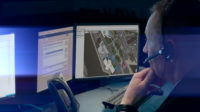Video Monitoring Today
Tying It All Together With Central Station Software
Central station software is crucial to today’s sophisticated video monitoring services.

Netwatch central station services are video-centric. Operators, known as intervention specialists, are trained to handle a wide range of video monitoring services.
IMAGE COURTESY OF NETWATCH

Bold's Video Control Center offering is integrated with dozens of video controllers, enabling central station operators to have a consistent interface, regardless of the controller manufacturer.
IMAGE COURTESY OF BOLD GROUP


Video monitoring is becoming increasingly sophisticated, making traditional services such as video verification and guard tours more effective — and paving the way for new, more proactive services aimed at deterring crime or providing functionality beyond security.
These new capabilities are enabled by technologies such as video analytics, artificial intelligence, machine learning and voice-down capability — technologies that often were not developed by central stations or the companies that provide the software on which central stations rely. The capabilities are much more powerful when they are integrated with central station software, however. While AI can generate alerts about potentially dangerous situations, those alerts typically must be verified by a human.
Integration Is Key
Central station software providers have recognized the importance of integrating with video devices, and have put a lot of work into achieving those integrations.
Colorado Springs, Colo.-based central station software provider Bold Group, for example, has developed an offering it calls Video Control Center that has 15 native drivers that were developed for the most popular video manufacturers, and devices that are compatible with the ONVIF standard, notes Thom Meyer, senior vice president of stages for Bold Group.
An additional 50 to 60 legacy integrations also work within the VCC framework. The VCC is available and live with Bold’s Manitou software and in in beta testing with Bold Stages software.
“Bold decided that what operators needed at a minimum was a single experience,” Meyer says.
Without a common user interface, operators might have to access video from some controllers via an app, while other controllers might send a video link and another might rely on a software development kit.
AI VIDEO ANALYTICS BENEFITS
Calipsa asked, “Which benefits have you experienced using AI video analytics?”
A recent video monitoring survey conducted by Calipsa found that the top benefits of AI were reduced false alarms, greater efficiency, reduced workload and faster response times.
// SOURCE: CALIPSA VIDEO MONITORING REPORT 2020
AI Is Hot
Almost everyone interviewed for this story agreed on one thing. As Brandon Niles, senior director for Lafayette, La.-based central station Acadian Total Security, puts it, “The biggest thing we’ve seen in the past year is Silicon Valley getting into security.” As a result, he notes, “We’ve seen more artificial intelligence.”
For now, the most common application for AI in central stations is filtering false alarms, according to Niles — but what he sees coming is pretty intriguing.
He points to gun detection — not to be confused with gunshot detection — as an emerging AI application. And while gunshot detection generates alerts in the midst of an attack, a prompt response to gun detection may be able to deter an attacker.
Niles adds that AI capabilities such as gun detection will need to be augmented by live operators, who will confirm if the AI was accurate in detecting a gun.
While video analytics and AI are sometimes used interchangeably, Morgan Hertel, vice president of technology and innovation for Syracuse, N.Y.-based central station Rapid Response Monitoring Services, sees one key difference between the two terms. As he explains, video analytics focuses on something very well defined that is triggered — a car going the wrong direction, for example.
The analytics software then makes a decision based on what it was told to do.
“AI takes input from lots of sources and makes decisions,” Hertel explains. “To work, you need the concept of deep learning.”
Hertel points to the example of a dumpster. Using deep learning, an AI system might determine that the dumpster is emptied every Wednesday morning and could be taught to generate an alarm if there is a week when the dumpster isn’t touched at the usual time.
Analytics and AI can be integrated with central station software in a variety of ways, Hertel says. One option is to use a video controller or video analytics engine at the customer premises that has been integrated with specific central station software. The companies that supply the software typically have lists available of equipment that will integrate with the central station.
Alternatively, some central station software vendors have plug-ins available for their software that adds video analytic or AI capability by analyzing video streams from the customer’s equipment. A third option is to use a cloud service that has been integrated with the central station software and with the video equipment at the customer premises.
Creative Applications
Monitoring companies continue to develop creative new ways to use central station software.
Immix CEO Chris Brown notes that adding sensors to high-value assets can enhance a central station’s ability to track down thieves. He points to the example of a pill bottle that triggers global positioning capability when removed from its storage position. The GPS can trigger a camera in the vicinity, enabling the central station to view video of when the asset was taken and who took it.
“When you add just that one little piece, suddenly you change the whole dynamic of how you’re able to capture and recover those types of assets,” Brown says.
Another valuable service that central stations can offer applies to companies that require two employees to be present when a retail business cashes out for the day. When only one employee is available, a central station operator can serve as the second set of eyes at cash-out time, according to Brown.
The operator can be summoned by a push button or video, and a script and instructions can automatically appear on the operator’s screen when a safe is opened.
Another interesting application comes from Allstate Security Industries, whose accounts include a cotton warehouse that wanted protection against the fires that can occur if the temperature of the stored cotton exceeds a certain threshold. The chosen solution was to monitor a thermal camera that can detect elevated temperatures before fire becomes a serious risk, explains Allstate CEO Randall Renfroe.
One example of a cloud-based video analytics/ AI offering comes from Bay City, Mich.-based central station software provider Dice.
As Avi Lupo, Dice co-president, explains, the offering analyzes content from customers’ video systems in real time and can detect guns and notice if someone is talking on a cellphone in a parking lot for 10 minutes. Various types of events are given various priority levels.
The offering can support services such as remote guarding or can act as a mini command center. Operators can see nine cameras simultaneously.
Lupo sees the offering as an excellent opportunity for dealers that already have an installed base of video customers. He cites the hypothetical example of a dealer that has 100 video sites, each with 10 cameras. Even if only 10 percent of those customers opt for the video analytics service, the dealer has the opportunity to make an additional $10,000 to $20,000 in recurring revenue.
Another cloud-based analytics/AI offering comes from Ashburn, Va.-based Calipsa, which focuses on using the technology to enhance false alarm filtering.
Some central stations use the offering as a sort of secret sauce to enable central station operators to work more efficiently and maximize their resource pool, explains Brian Baker, chief revenue officer for Calipsa. Others may charge extra for the capability.
What the customer ultimately pays per month may depend on whether the customer is charged per activation or based on a flat monthly rate.
The Calipsa offering also can be helpful in supporting virtual concierge services, Baker notes.
Several people interviewed for this article — including Chris Brown, CEO of Tampa, Fla.-based central station software provider Immix and Mike Weymer, CEO of Dallas-based central station Electroguard — note that AI/ analytics also can make or will soon be able to make video guard tours more efficient. By analyzing the scene viewed by each camera, AI can minimize the amount of time central station operators have to spend looking in on cameras.
“With AI, it’s not necessary to [look at] every camera every hour,” Weymer explains.
“If [the AI] sees a threat, it hands it to a live operator,” Brown adds.
An Important Video Monitoring Certification
UL 827B certification covers managed video service providers that deliver security services by leveraging video cameras and related video technologies installed at protected properties to form all or part of an electronic security system. According to UL, “The managed video service provider employs staff located at a Managed Video Monitoring Station (Command Center/Central Station) to view video streams, make situation-awareness informed decisions, interact with people or systems at a protected property, notify identified parties of events, or other services as detailed in a written agreement between the managed video service provider and its subscriber.”
Advanced Capabilities
One particularly useful capability within the broad category of video analytics/AI is facial recognition. Niles notes, for example, that facial recognition can be very useful in protecting a woman with a restraining order against an ex-husband.
The technology also can help filter false alarms. Hertel says, for example, that video customers monitored by Rapid Response have the option of providing the central station with their photo albums to establish a database of friendly faces that won’t trigger an alarm if caught on video.
Some people interviewed for this article — including Brown and Randall Renfroe, CEO of Amarillo, Texas-based central station Allstate Security Industries — note that two-way audio capability also can enhance a central station operator’s ability to deter crime. When a video alert is generated, the ability to say, “You in the plaid shirt, you are intruding and we have you on video” can help change a would-be perpetrator’s plans about the crime he had in mind.
It’s worth noting that the effectiveness of voice-down capability also relies on the instructions and script that pop up in the central station automation software as the video is delivered to the central station operator.
Video as the Alarm System
As video monitoring becomes more sophisticated, Netwatch, a central station company focused on video monitoring and based in Lake Forest, Calif., sees video as having the potential to replace a traditional alarm system. Included on the list of services available from Netwatch is something called ‘proactive video monitoring.’
“Video is the alarm system, if you will,” explains Justin Williams, president of Netwatch North America. “Like with intrusion, proactive video can be armed through a keypad, through an app or through a schedule.” The video systems can also be partitioned with multiple zones and, if desired, end users can arm only certain zones.
The proactive video monitoring offering can be thought of as security-as-a-lifestyle. A key goal of the service is to make sure that the customer is interacting with the service, Williams says.
Rather than being known as operators, the central station personnel who support the proactive video offering are known as “intervention specialists” and they are often brought on to replace traditional guards.
"[With the assistance of AI] we detect, verify, intervene and respond,” Williams says.
Analytics/AI is also top of mind for Atlanta-based EyeQ Monitoring, another central station devoted to video monitoring.
According to Markus Scott, EyeQ CEO, the company is developing a lot of cutting-edge monitoring services — and although he declined to provide much detail about them, he made them sound very intriguing.
“We have a great vantage point to understand what algorithm needs to be built to drive value,” he teases.
Key industries that EyeQ targets include education, property management and retail. The central station develops individual solutions for its clients, Scott explains.
“We’re doing more than just security,” Scott says. “We’re using video to be eyes and ears in other ways as well. ... We’re in the human and business automation [business]. We’re using surveillance to augment human jobs, whether that’s a guard or a concierge.”
Looking for a reprint of this article?
From high-res PDFs to custom plaques, order your copy today!








